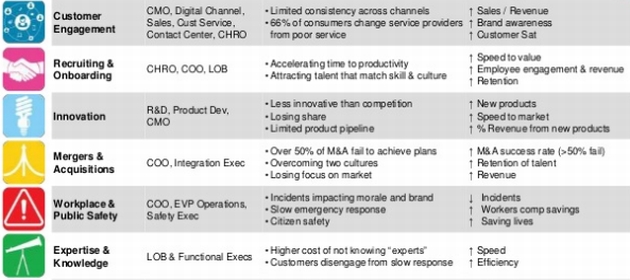There’s a growing realization among B2B technology marketers that positioning their products and services around technology is a fool’s errand. Even compared to a year or two ago, there’s a massive rise in vendors recasting technology offerings around alleviation of business pain areas.
This is a great development. We’d like to take some credit for it since we’ve incessantly advocated this approach from Day One and used Marketable Items to realize it.
Whether we deserve to pat our backs or not for this change in thinking from “inside-out” to “outside-in” is peripheral to this blog post, the primary purpose of which is to address the following challenge faced by many tech vendors in executing this approach:
What if there are no pain areas?
Well, every company has hiccups. Even a casual glance at any company’s public announcements would prove that, regardless of where it’s located or which industry it belongs to, no company is immune to pain points. The real challenge is in finding them.
While crafting Marketable Items for various tech companies, we’ve found three ways to uncover pain areas:
- Drill down
- Bubble up
- Spread across
Let me explain each method in detail.
Drill down
Everything might look hunky dory at the overall company level. However, scratch the surface, you might find that not all SBUs of the company are in the same boat. By drilling down to various businesses, you can find pain areas unique to that business. Whether the solutions to those pain areas are relevant only to that SBU or applicable to the whole company, this approach presents a good opportunity to plug your product or service.
Bubble up
 Company insiders might be oblivious to various issues. But, when seen from the outside, these issues may be one step away from becoming problems.
Company insiders might be oblivious to various issues. But, when seen from the outside, these issues may be one step away from becoming problems.
Tech vendors should go beyond what the prospect aritculates and bubble up the latent pain points to the surface. Let me illustrate this with the following real life example.
One of our customers was pitching its ERP solution to a tire manufacturer. Every time we visited the prospect for demos and presales meetings, we saw long queues of trucks parked outside the factory gate. At the time, this didn’t seem relevant to us. However, it started ringing alarm bells in our heads when we started discussing the production process. We learned that the company had multiple factories, with each being responsible for one of the many stages involved in a tire-manufacuturing process. For example, the plant we visited carried out the first stage of the process, namely “Compounding”, which “is the operation of bringing together all the ingredients required to mix a batch of rubber compound.” (Source: Wikipedia)
After compounding, the work-in-progress material would be transported to the second factory in the chain which would do “Mixing”, which “is the process of applying mechanical work to the ingredients in order to blend them into a homogeneous substance.”
So on and so forth until the fifth factory in the chain would “finish” the tire.
It became obvious to us that that there could be delays in the handoff of WIP material from one factory to the other if their production processes weren’t perfectly in synch. This would mean that trucks would have to wait for 3-4 days to collect the material.
This tallied with the long lines of trucks we sighted outside the factory gate. It was obvious that the trucking company would seek compensation for idling of its trucks. A side discussion with the company’s finance department revealed that the pain area we divined was right: The company was indeed paying hefty demurrage charges to the trucker.
Long story short, the company bought the ERP and recovered its investment by slashing the demurrage by half.
Spread across
While this approach can be a bit politically sensitive, it always works.
The aforementioned vendor’s business analysts demo’ed their ERP’s financial accounting module. The prospect’s finance department brushed them off summarily by asserting that their accounting software was perfect and didn’t need any upgrade. The business analysts didn’t take that as a no.
Instead, they went across to the sales department. They heard a very different story there: Even after they were collected, many invoices would still keep showing up as outstanding in the AR statements generated by the finance department’s accounting software.
The vendor’s team immediately understood that this company was suffering from the classical “before ERP” problem of poor integration between invoicing and collection point software.
They proposed alleviation of this pain point as a major soure of ROI in their presentation to the C-Suite. Their story resonated very strongly with the CxOs since they were used to constant sparring between the CMO and CFO about AR status during cash flow review meetings.
Pain areas exist in all companies. To sell any enterprise software, it’s absolutely necessary to uncover them, even if they’re not obvious.
Uncovering pain areas may call for domain expertise and the knack of probing beyond what is explicitly stated by a prospect. If you need any assistance with this, we’re there!



